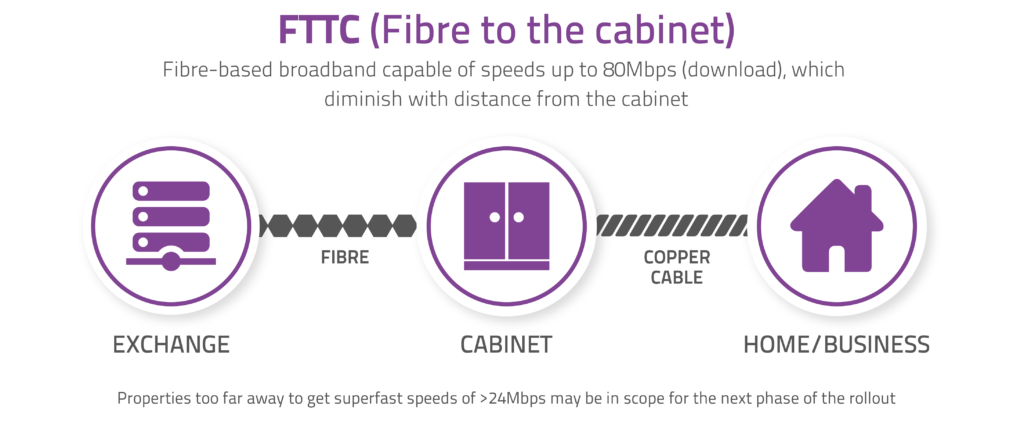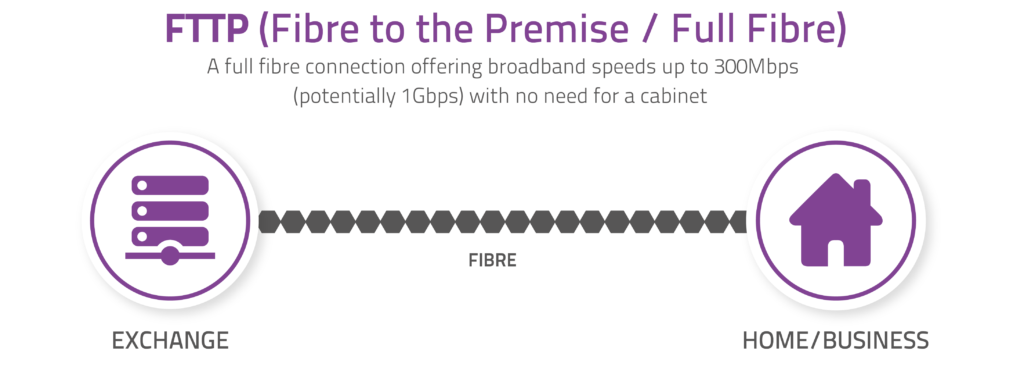Whilst fibre broadband is the most common solution to bring high speed internet access, there are a number of alternative technologies that could improve connectivity for your home or business where fibre broadband is difficult to deliver.
Full fibre broadband
Fibre technology used to deliver broadband includes Fibre to the Cabinet (FTTC) and the newer Fibre to the Premise (FTTP). Both will deliver superfast speeds of 24Mbps, and higher.
You choose the speed package to suit your needs and budget. We’ve explained the options below or go to our getting better broadband page to find out what you can get in your area and how to upgrade.
Fibre to the Cabinet (FTTC)
Up to now, most of the superfast broadband rollout has been delivered through Fibre to the Cabinet (FTTC), using fibre optic cables from the telephone exchange to a new green street cabinet and then existing copper wires to connect to the property.

FTTC can deliver superfast speeds from 24 Mbps up to 80Mbps (download), depending on the distance from the cabinet.
Where properties are too far away from the fibre cabinet to get superfast speeds using FTTC, the solution has sometimes been to build a new fibre cabinet closer to them, using copper rearrangement to move the existing broadband connection to boost speeds.
FTTC is slowly being phased out by Openreach as an option in some areas – this will happen when an exchange area has reached a certain level of FTTP coverage – i.e. they will then ‘stop selling’ FTTC (please note this will only apply to a new order or an upgrade for those premises on the exchange who are able to order FTTP instead (so if FTTP is not available at a premise, the ‘stop sell’ will not be applied)). More details about FTTC stop sells can be found on the Openreach website.
Fibre to the Premise (FTTP)
The latest Fibre to the Premise (FTTP) technology is now being used to connect harder to reach areas. Using fibre optic cable running directly from the telephone exchange to the property, either via underground ducts or overhead cables on telegraph poles.

FTTP offers faster speeds of up to 300Mbps on current broadband packages and is gigabit-capable (1000mbps), so is more future proof. However, you can still use it for lower speed packages depending on your requirements.
The short video below explains the process and the benefits of FTTP:
How to order FTTP
Not all Internet Service Providers offer FTTP services yet, although more will become available as the full fibre network expands. Check which suppliers might be active in your area on our postcode checker or use an independent broadband comparison website. We also have a list of active suppliers who we know are delivering broadband in Cambridgeshire and Peterborough so you can check with them directly.
You pay for the speed package that you order, regardless of the technology. Higher speeds via FTTP may cost more, or you can still order superfast speeds at the same prices as Fibre to the Cabinet (FTTC) customers.
Gigabit broadband is predominantly delivered by a FTTP. Virgin Media O2’s entire network is gigabit-capable although not all currently full fibre. The existing HFC (hybrid fibre coax) network is due to be upgraded to FTTP by the end of 2022 in Cambridgeshire.
More information about FTTP, FTTC and broadband in general can be found on our Broadband FAQs page.
Other broadband technologies
Although fibre broadband is the most common solution to bring high speed internet access, there are alternative technologies that could improve connectivity for your home or business.
These solutions are predominantly used for rural and isolated properties, but there are also some gaps in towns and cities, where fibre broadband is difficult to deliver:
Mobile broadband coverage is always improving and is one of the most accessible alternative solutions to getting a better broadband when fibre isn’t available.
Mobile broadband also has the added benefit of not being tied down to your property so you can take it out and about.
The 4G network currently covers 92% of the UK population and the average speed is 15Mbps (but capable of much faster speeds).
Mobile operators are also at the beginning of the rollout of 5G, which will provide faster mobile internet and more. We have more information on our Mobile pages.
If you use mobile broadband, check the coverage of your supplier. Maps can be found on supplier’s websites and overall mobile coverage can be found on the Ofcom website.
To check what mobile broadband packages are available you can use a comparison website such as Broadband Genie.
Satellite broadband is a widely available alternative solution for broadband and is now capable of speeds up 30Mbps – suitable for browsing the internet, reading your email, catch-up tv and video calls.
However, there are issues with latency due to the distance between the earth and the satellites – which affects fast paced online gaming.
Satellite broadband costs can vary and the installation of the equipment can be expensive, but some retailers will give you the installation for free if you sign up to a longer term contract. Use an independent online comparison website to find the best deal for you.
Find more information about satellite broadband on the ThinkBroadband website.
Wireless broadband offers high speeds without the need to lay infrastructure to your home.
Fibred-up to a local mast, the signal is then sent to a receiver at your home.
Wireless broadband is capable of high speeds with 40Mbps and higher available from many providers. It doesn’t suffer from latency issues (as with Satellite) and is fine for gaming and video calling.
Although not as widely available as some other alternative technologies, it is more common in rural areas where demand is high.
Some providers local to Cambridgeshire are:
For more information on this technology visit the ThinkBroadband website.
There are schemes available that you may wish to consider when looking to improve your current broadband connection. To find out more visit our Gigabit Broadband Voucher Scheme page.
